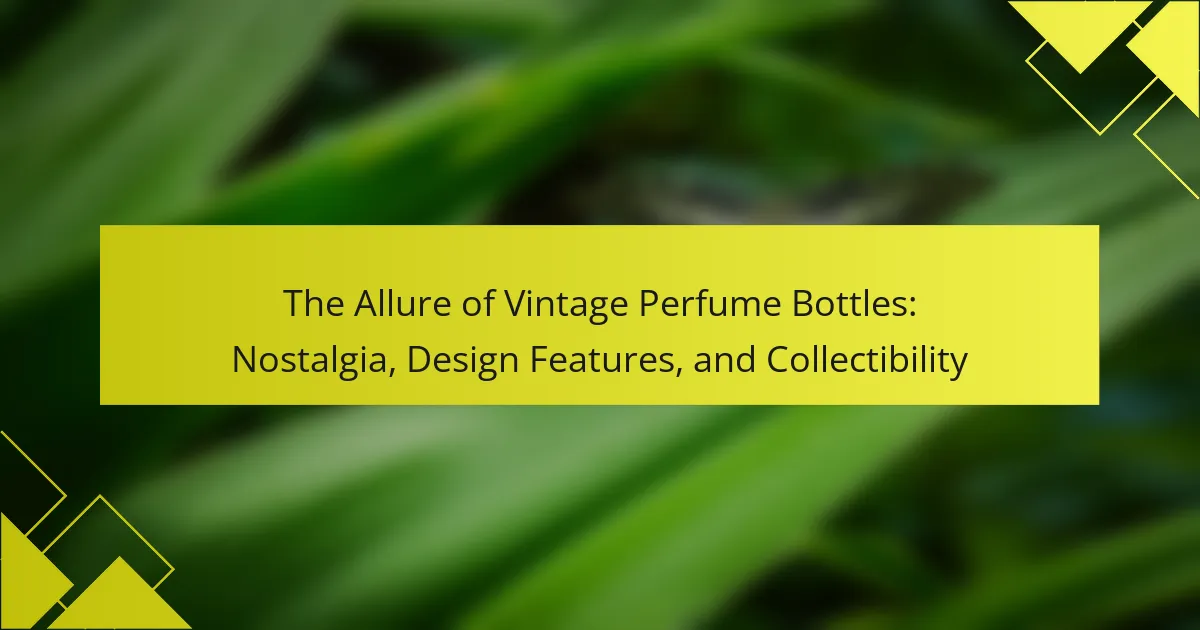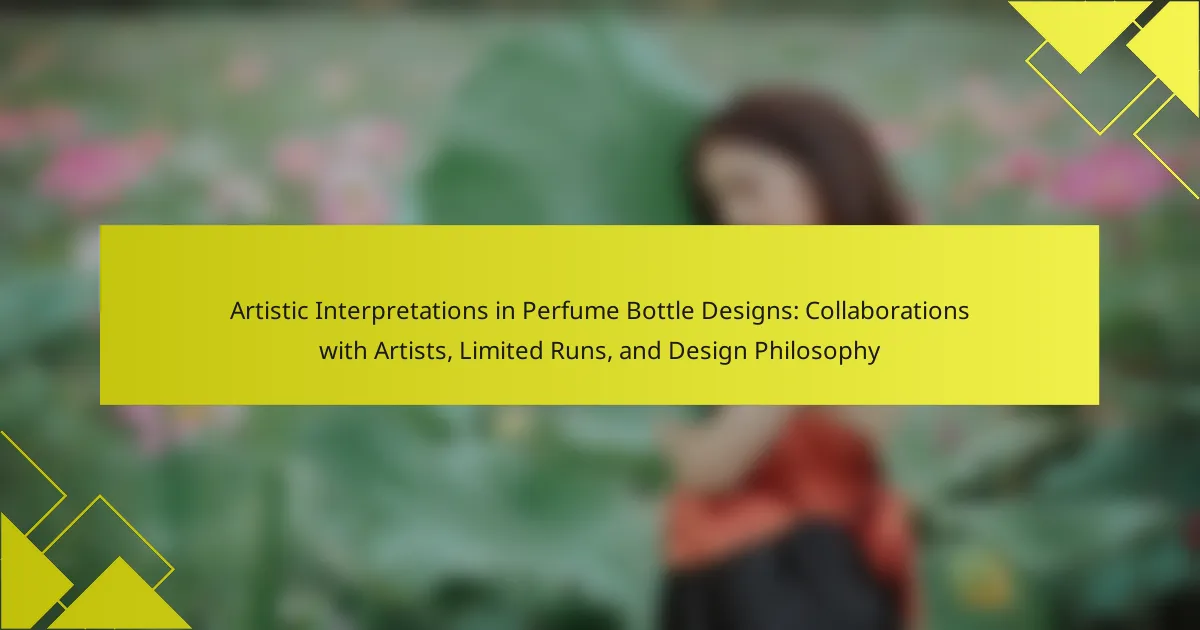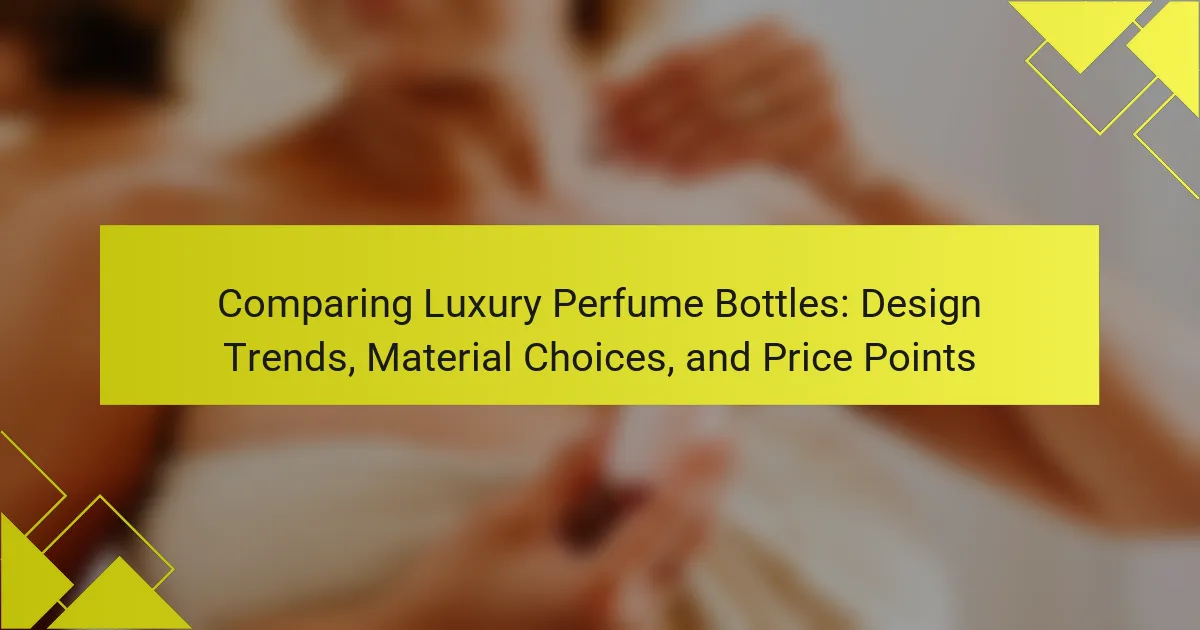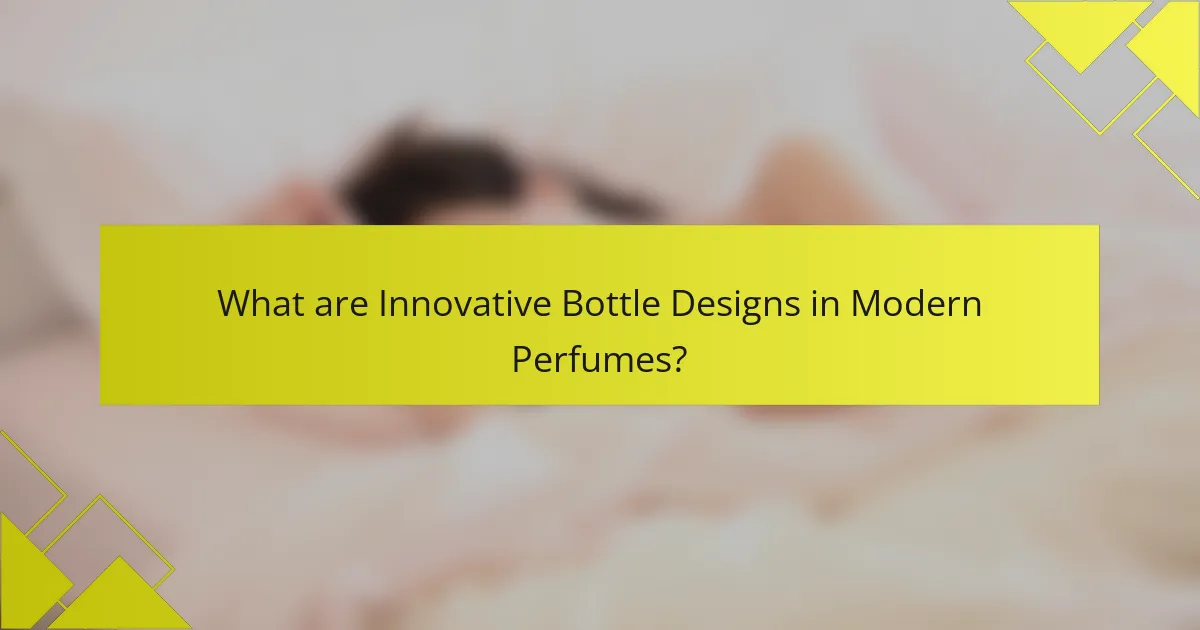
What are Innovative Bottle Designs in Modern Perfumes?
Innovative bottle designs in modern perfumes incorporate unique shapes, materials, and functionalities. These designs enhance user experience and appeal to aesthetic sensibilities. Many brands use sustainable materials to align with eco-friendly trends. Technology integration includes features like refillable systems and smart dispensing mechanisms. Ergonomic designs ensure ease of use and comfort during application. Customizable elements allow users to personalize their fragrance experience. Examples include bottles shaped like art pieces or inspired by nature. Such innovations reflect the evolving landscape of the fragrance industry, merging artistry with practicality.
How have bottle designs evolved in the perfume industry?
Bottle designs in the perfume industry have evolved significantly over time. Initially, perfume bottles were simple glass containers with minimal decoration. As the industry progressed, designs became more elaborate and artistic. In the early 20th century, luxury brands began creating uniquely shaped bottles to reflect their brand identity. The use of high-quality materials, such as crystal and metal, became common in the 1920s and 1930s.
In recent years, technology has influenced bottle design. Brands now incorporate ergonomic features for better usability. User experience is prioritized, with designs that are visually appealing and functional. Sustainable materials are increasingly used in response to environmental concerns.
Overall, the evolution of bottle designs in the perfume industry reflects changing consumer preferences and advances in technology. This evolution is evident in the diversity of shapes, materials, and functionalities seen in modern perfume bottles.
What historical influences shaped modern bottle designs?
Modern bottle designs are shaped by several historical influences. The ancient Egyptians used glass and ceramic for storage, leading to aesthetic innovations. In the 19th century, the introduction of glassblowing techniques allowed for intricate shapes. Art Nouveau and Art Deco movements emphasized artistic expression in bottle design. The rise of branding in the 20th century influenced unique shapes and logos. Additionally, the shift towards sustainability has led to eco-friendly materials in recent designs. These historical elements collectively inform the aesthetic and functional aspects of contemporary bottles.
How do cultural trends impact bottle design aesthetics?
Cultural trends significantly influence bottle design aesthetics. Designers often reflect societal values and preferences in their creations. For instance, the rise of minimalism has led to simpler, cleaner bottle shapes. This trend emphasizes functionality and sustainability, aligning with consumer demand for eco-friendly products. Additionally, cultural movements such as retro and vintage styles have revived classic bottle designs, appealing to nostalgia. Color palettes also shift with cultural trends, as seen in the popularity of pastel colors in recent years. Market research indicates that brands incorporating cultural elements in design see increased consumer engagement. Thus, cultural trends shape both the visual and functional aspects of bottle design.
Why is technology integration important in perfume bottle design?
Technology integration is important in perfume bottle design because it enhances functionality and user experience. Advanced technology allows for features like spray mechanisms that deliver a fine mist. This improves the application of fragrance, making it more enjoyable for users. Moreover, smart technology can enable refillable systems, reducing waste and promoting sustainability. Additionally, technology can facilitate unique designs that attract consumers. For instance, LED indicators can show the amount of fragrance left. This integration ultimately leads to a more efficient and appealing product. As consumer preferences evolve, technology integration ensures that designs remain relevant and competitive in the market.
What technologies are commonly used in modern bottle designs?
Modern bottle designs commonly utilize technologies such as 3D printing, smart materials, and automated manufacturing processes. 3D printing allows for rapid prototyping and customization of bottle shapes. Smart materials can change properties based on environmental conditions, enhancing functionality. Automated manufacturing processes improve efficiency and precision in production. Additionally, sustainable materials are increasingly used to reduce environmental impact. These technologies contribute to innovative designs that enhance user experience and ergonomics in modern perfumes.
How does technology enhance functionality in perfume bottles?
Technology enhances functionality in perfume bottles through features like spray mechanisms, smart sensors, and refillable designs. Advanced spray mechanisms allow for a fine mist application, improving fragrance distribution. Smart sensors can measure usage and provide reminders for refills, enhancing user experience. Refillable designs promote sustainability by reducing waste. Additionally, some bottles incorporate temperature control to preserve fragrance quality. These innovations improve usability and appeal to eco-conscious consumers. Overall, technology significantly elevates the practicality and enjoyment of using perfume bottles.
What role do ergonomics play in perfume bottle designs?
Ergonomics significantly influence perfume bottle designs by enhancing user comfort and usability. Well-designed bottles fit comfortably in the hand, allowing for easy application. This reduces the risk of spills and improves the overall user experience. Ergonomic designs consider factors such as grip, weight distribution, and ease of pressing the spray mechanism. Research shows that ergonomic products lead to higher customer satisfaction and increased usage frequency. Brands that prioritize ergonomics often see improved sales and customer loyalty. Effective ergonomic design can differentiate a product in a competitive market.
How do ergonomic designs improve user experience?
Ergonomic designs improve user experience by enhancing comfort and usability. They are tailored to fit the natural posture and movements of users. This reduces strain and fatigue during use. For example, ergonomic bottle designs allow for easier gripping and pouring. Research shows that products designed ergonomically can lead to increased user satisfaction. A study published in the Journal of Ergonomics found that ergonomic designs can reduce physical discomfort by up to 30%. This improvement in comfort translates to a more enjoyable user experience overall.
What are the key ergonomic features in successful perfume bottles?
Successful perfume bottles feature several key ergonomic elements. These include a comfortable grip that allows for easy handling. Additionally, a well-designed spray mechanism ensures a smooth and controlled application. The bottle shape often promotes stability to prevent tipping. Lightweight materials contribute to ease of use. Clear labeling helps users identify the fragrance quickly. A compact size enhances portability for on-the-go use. These features collectively improve the user experience, making the perfume more accessible and enjoyable.
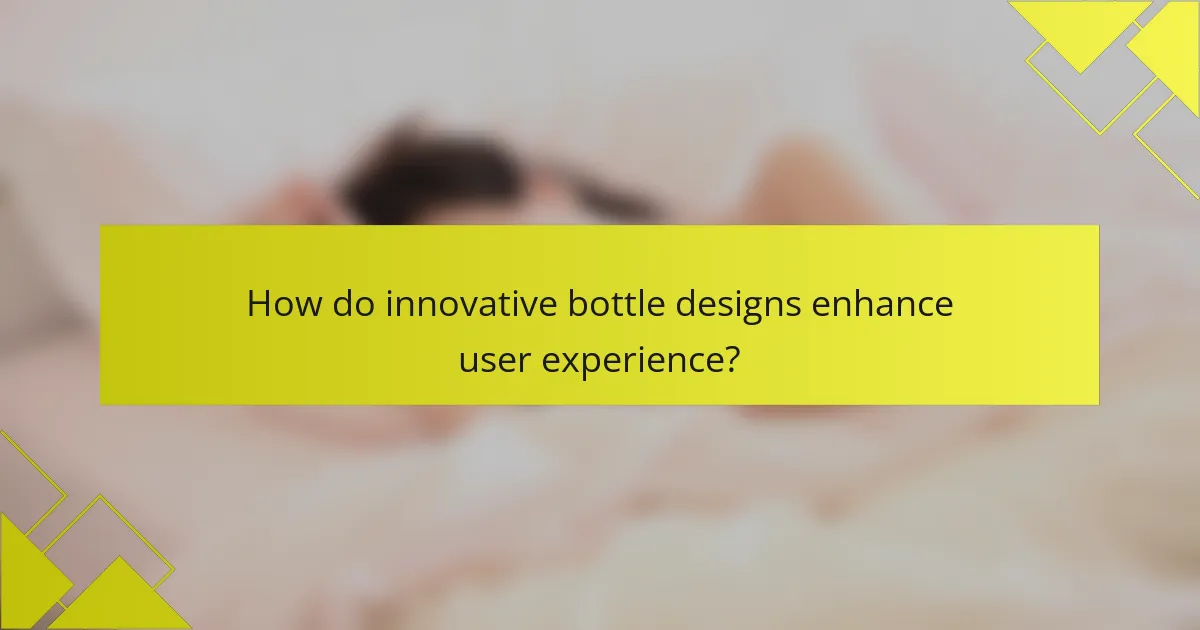
How do innovative bottle designs enhance user experience?
Innovative bottle designs enhance user experience by improving functionality and aesthetics. Ergonomic shapes allow for comfortable handling and easier application. Unique materials can provide a premium feel, enhancing the overall perception of the product. Interactive features, such as spray mechanisms, can improve usability and control. Transparency in design allows consumers to see the product level, fostering trust. Sustainable materials appeal to environmentally conscious consumers, enhancing brand loyalty. Customization options can create a personal connection with users. These elements collectively create a more satisfying and engaging experience, leading to increased consumer satisfaction and repeat purchases.
What are the psychological effects of bottle design on consumers?
Bottle design significantly influences consumer psychology. Aesthetic appeal can create emotional connections. Attractive designs often evoke positive feelings, enhancing brand perception. Research indicates that unique shapes can increase perceived value. Consumers may associate elegance with specific design elements. Functionality also plays a role; ergonomic designs improve user experience. Positive experiences lead to brand loyalty. In summary, bottle design affects emotions, perceptions, and purchasing decisions.
How does the visual appeal of a bottle influence purchasing decisions?
The visual appeal of a bottle significantly influences purchasing decisions. Attractive designs capture consumer attention and create a positive first impression. Research shows that 70% of purchasing decisions are made in-store, highlighting the importance of visual elements. A well-designed bottle can evoke emotions and convey brand values. Colors, shapes, and materials contribute to perceived quality. For instance, luxury brands often use sleek, elegant designs to enhance desirability. Studies indicate that consumers associate aesthetic appeal with product effectiveness. Therefore, the visual appeal of a bottle plays a crucial role in attracting buyers and driving sales.
What role does tactile experience play in user satisfaction?
Tactile experience significantly enhances user satisfaction by creating a more engaging interaction with products. The feel of a product influences perceptions of quality and usability. For instance, soft-touch materials on perfume bottles can evoke a sense of luxury. Research indicates that tactile feedback can increase emotional attachment to a product. A study by Spence et al. (2016) highlights that tactile sensations can affect consumer preferences and purchase intentions. Therefore, incorporating tactile elements in innovative bottle designs can lead to higher user satisfaction.
How do brands differentiate themselves through bottle design?
Brands differentiate themselves through bottle design by creating unique shapes, materials, and visual aesthetics. Distinctive bottle shapes can enhance brand recognition and appeal to specific consumer demographics. For instance, a sleek, modern design may attract a younger audience, while classic shapes may appeal to traditional consumers.
Materials used in bottle construction also play a crucial role. Brands often opt for glass, plastic, or metal to convey luxury or sustainability. For example, eco-friendly brands may choose recycled materials to align with their values.
Visual elements such as colors, labels, and finishes further enhance differentiation. A bold color scheme can make a product stand out on shelves. Innovative features like ergonomic designs improve user experience, making the bottle more functional.
Evidence shows that consumers often make purchasing decisions based on packaging. A study by the Packaging Association found that 72% of consumers say packaging design influences their buying behavior. Therefore, effective bottle design is essential for brand identity and market success.
What unique attributes can be found in signature bottle designs?
Unique attributes in signature bottle designs include distinctive shapes, materials, and artistic elements. These designs often feature ergonomic contours for comfortable handling. Signature bottles may use premium materials like glass or metal to convey luxury. Unique closures, such as custom caps or pumps, enhance functionality and aesthetics. Limited edition designs often incorporate exclusive colors or patterns. Some bottles showcase intricate artwork or engraving, making them collectible items. These attributes contribute to brand identity and consumer appeal.
How do limited edition bottles create exclusivity and value?
Limited edition bottles create exclusivity and value through scarcity and unique design. Scarcity increases demand among consumers. When fewer bottles are available, collectors and enthusiasts are more likely to purchase them. Unique designs often feature artistic elements that differentiate them from standard offerings. This artistic touch adds perceived value. Additionally, brands may collaborate with well-known artists or designers for these editions. Such collaborations enhance the bottle’s appeal and marketability. Historical examples include the 2019 limited edition of Chanel No. 5, which featured a unique bottle design. This bottle sold quickly, reflecting its value among consumers. Overall, limited editions leverage scarcity and artistry to create a sense of exclusivity and higher value.
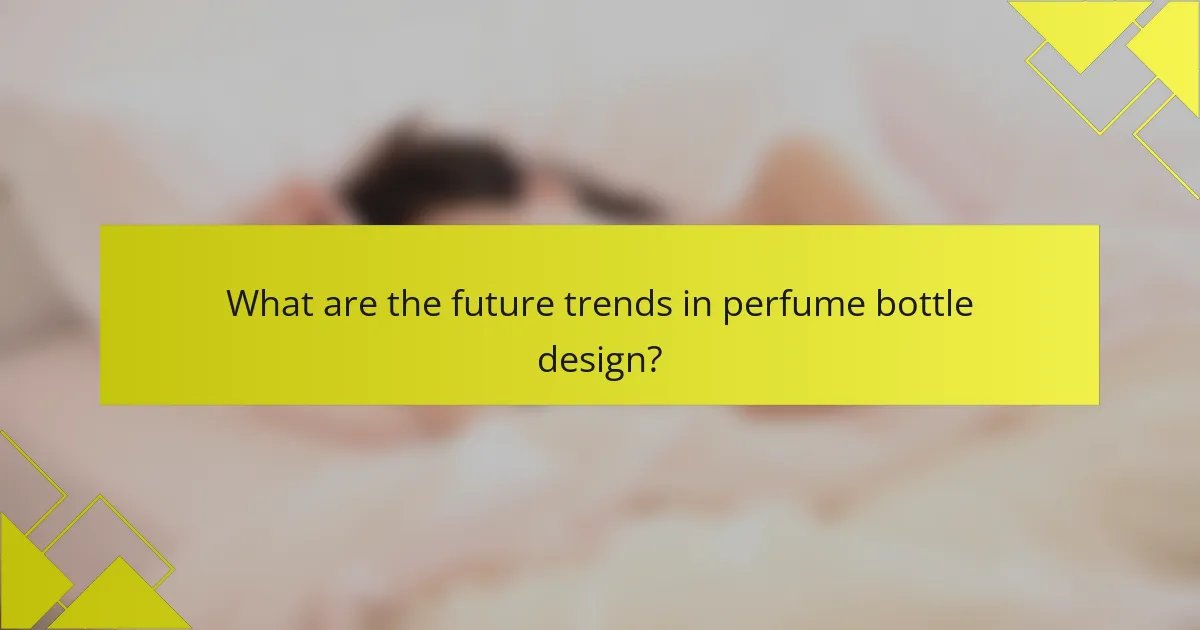
What are the future trends in perfume bottle design?
Future trends in perfume bottle design include sustainable materials, smart technology integration, and ergonomic shapes. Designers are increasingly using eco-friendly materials to reduce environmental impact. This shift aligns with consumer demand for sustainability. Smart technology features, such as app connectivity and refillable systems, enhance user experience. Ergonomic designs focus on comfort and ease of use. Minimalist aesthetics are also gaining popularity. These trends reflect a broader movement towards personalization and functionality in fragrance packaging.
How is sustainability influencing modern perfume bottle designs?
Sustainability is significantly influencing modern perfume bottle designs by prioritizing eco-friendly materials and production processes. Brands are increasingly using recycled glass and biodegradable plastics. This shift reduces environmental impact and promotes circular economy principles. Many companies are also focusing on refillable bottle designs. Refillable options decrease waste and encourage consumers to reuse their containers. Additionally, brands are adopting minimalistic designs to reduce material usage. This trend aligns with consumer preferences for sustainable luxury. Research indicates that 73% of millennials are willing to pay more for sustainable products. This growing demand drives innovation in sustainable packaging solutions within the perfume industry.
What materials are emerging as eco-friendly alternatives?
Bioplastics and recycled glass are emerging as eco-friendly alternatives in packaging. Bioplastics, made from renewable sources like corn starch, reduce reliance on fossil fuels. Recycled glass minimizes waste and energy consumption during production. Bamboo is also gaining traction due to its rapid growth and biodegradability. These materials align with sustainability goals in the beauty industry. Research indicates that using recycled materials can cut carbon emissions significantly. Brands adopting these alternatives demonstrate a commitment to environmental responsibility.
How are brands incorporating refillable options in their designs?
Brands are incorporating refillable options in their designs by creating bottles that allow easy refilling. These designs often feature removable caps or pumps for user convenience. Many brands are using sustainable materials to encourage eco-friendly practices. Refillable systems are often paired with dedicated refill stations in stores. Some brands offer online refill services for added accessibility. This approach reduces waste and promotes a circular economy. Research shows that consumers are increasingly favoring sustainable packaging solutions. According to a 2021 survey by McKinsey, 60% of consumers prioritize sustainability in their purchasing decisions.
What best practices should brands consider for innovative bottle designs?
Brands should prioritize functionality and aesthetics in innovative bottle designs. A well-designed bottle enhances user experience and encourages repeat purchases. Ergonomic shapes improve grip and usability. Sustainable materials appeal to eco-conscious consumers. Unique designs can differentiate products in a competitive market. Incorporating technology, such as smart features, adds value and modern appeal. Research shows that visually appealing packaging can increase perceived product quality. Brands should also consider ease of manufacturing and cost-effectiveness in their designs.
How can brands balance aesthetics with functionality in bottle design?
Brands can balance aesthetics with functionality in bottle design by integrating visually appealing elements with practical features. This includes using ergonomic shapes that are comfortable to hold while ensuring the bottle is easy to open and dispense. Materials can be chosen for both their aesthetic qualities and their durability, such as glass for elegance and plastic for lightweight convenience.
Color schemes and textures can enhance the visual appeal without compromising the user experience. For example, matte finishes can provide a sophisticated look while offering a non-slip grip. Additionally, incorporating technology, such as spray mechanisms that deliver a fine mist, can enhance functionality without detracting from design.
Research shows that consumers often prefer bottles that are both beautiful and functional, leading to higher satisfaction and repeat purchases. A study published in the Journal of Product Innovation Management found that products combining aesthetics and usability increase consumer loyalty.
What common pitfalls should be avoided in perfume bottle design?
Common pitfalls in perfume bottle design include neglecting user ergonomics. A poorly shaped bottle can make it difficult to hold and spray. Additionally, overly complex designs may hinder usability. Bottles that are too heavy can be cumbersome for consumers. Using materials that do not preserve fragrance integrity is another mistake. Inappropriate closure mechanisms can lead to leaks or spills. Failing to consider shelf space and display can limit retail appeal. Lastly, ignoring brand identity in design can confuse consumers about the product. Each of these pitfalls can negatively impact the user experience and overall product success.
Innovative bottle designs in modern perfumes serve as a focal point of the fragrance industry, integrating technology, ergonomics, and sustainability. This article explores the evolution of bottle designs, highlighting the impact of historical influences and cultural trends on aesthetics. Key topics include the role of technology in enhancing functionality, the importance of ergonomic features for user satisfaction, and the emerging focus on eco-friendly materials and refillable options. Additionally, it examines how brands differentiate themselves through unique designs and the psychological effects of visual appeal on consumer purchasing decisions.
